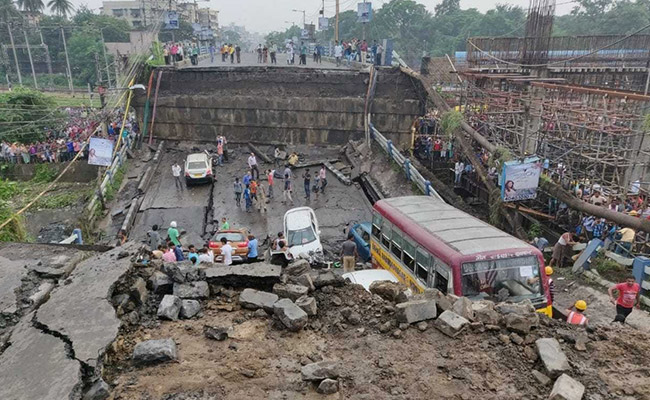

Majerhat Bridge Collapse: Same Old Story of Shamelessness
It is not surprising that blame games have started after the collapse of Majerhat Bridge in Kolkata. Politicians and bureaucrats love to pass the buck and accidents are the best time to indulge in some fancy passing. It is important to know whether the collapse happened due to vibrations induced by the work being done by the railways nearby or due to the negligence of the state PWD. But what is definitely more important is to know why a bridge that was the lifeline of the city, connecting Behala, Thakurpukur, Joka, Amtala upto Diamond Harbour to the rest of the city, especially the port area in the city and across the river to Howrah and that spawned across major suburban railway lines was treated in such a cavalier manner by all agencies state and Central.By Sunil Garodia
First publised on 2018-09-04 22:03:41
Let us assume for a moment that the bridge collapsed due to vibrations from the pillaring being undertaken by the railways nearby. Was it not the duty of both the railways and the state PWD to make a fair assessment of the condition of the bridge before starting the work? Was it not required that supporting mild steel girders and pillars were placed under the sections of the bridge that were identified as weak and prone to collapse if vibrations occurred nearby? If railways conduct any work in a city, is it not the duty of the state PWD or the local corporation to ensure that they do not damage the existing infrastructure of the city? But on the face of it, the vibration theory does not wash as just two kilometers down the road is the old Behala area where centuries old private houses stand. The Metro railways have constructed more than 300 pillars on the Diamond Harbour Road without reports of any of the buildings collapsing. When the first Metro rail project was being carried out in Kolkata, numerous old buildings on the Chittaranjan Avenue were supported with garters and pillars to prevent an accident. Why was this not done in case of the Majerhat Bridge?
Then, major repair work on the bridge was long overdue. The structure carries a huge workload with a steady stream of trucks ferrying machinery or goods from the port area to the factories located in Amtala and Faltas Special Economic Zone. Apart from that, a huge number of public transport and private vehicles use the bridge daily. Considering the load factor, the upkeep of the bridge was grossly neglected. During the recent monsoons, newspapers in Kolkata had highlighted the gaping potholes on the bridge that were causing severe distress to motorists and could have caused a major accident. Somewhere, somehow the rain had also played a part in further weakening and already weak structure. The state PWD cannot deny that it has been totally negligent in maintaining the bridge.
After the collapse, no patchwork will do. Since the bridge carries a huge load daily, the ideal response should be to raze the dilapidated structure completely and replace it with a new, modern and perhaps wider, bridge. The funds needed should be arranged, if need be with contribution from the railways and the city should be given a new and lasting asset to erase the horrific memory of the collapse. This is also an ideal time to carry out a detailed study of all bridges in the city and undertake comprehensive repair work wherever necessary.











